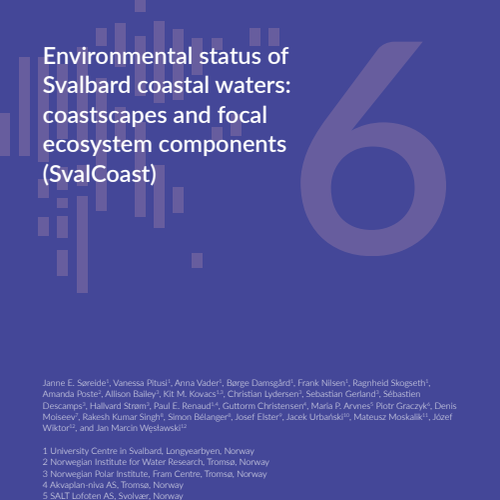19 January 2021 news
Arctic coasts
Coastal waters, with a strong coupling between sea and land, are among the most productive regions in the Arctic. In addition, the shallow sea depths create a tight pelagic-benthic coupling. These regions are also critical breeding and foraging grounds for many invertebrates, fish, bird, and marine mammal species. These various groups of animals provide valuable ecosystem services and many of them are vulnerable to anthropogenic and climate-induced stressors.
The Svalbard coast
In Svalbard, nearshore ecosystems are being impacted directly by global warming. This causes reduction of landfast sea ice, retreat of marine terminating glaciers, altered wind and wave, circulation and stratification patterns as well as more indirect impact from climate change on land like permafrost thaw, melting of glaciers, changes in precipitation and runoff. This has a broad range of implications for physical and biogeochemical conditions in Svalbard’s coastal waters, including changes in nutrient concentrations and the underwater light regime, as well as direct physical changes to coastal habitat structure. In turn, these changes are likely to impact the primary productivity and biodiversity of Svalbard’s coastal waters. Akvaplan-niva, by Guttorm Christensen and Paul Renaud, has contributed to a recently published synopsis on the state of the Svalbard coast (see document below).
Arctic Council Coastal Expert Monitoring Group
At present, the extent of protected coastal marine ecosystems in the Arctic remains minute in comparison to terrestrial areas. As Arctic biodiversity is under pressure managers, industries, conservation organisations, and communities need access to timely and complete biodiversity status and trend data. This is the background for the recent establishment of a Coastal Expert Monitoring Group (CEMG). This group is part of the Circumpolar Biodiversity Monitoring Program (CBMP) under the Arctic Council working group Conservation of Arctic Flora and Fauna (CAFF). The goal of CEMG is to develop a longterm, integrated and multi-disciplinary circumpolar Arctic coastal biodiversity monitoring plan in 2023. ‘State of Arctic Coastal Biodiversity Report’. A newly published synopsis, with an overview of Svalbard coastscapes and its essential focal ecosystem components (FECs) inhabiting these coasts, will be an important contribution to this pan-Arctic synthesis to be ready in 2023.
The Svalbard synopsis
The Svalbard synopsis address the following three main objectives:
1. Provide an overview of the extent of the different coastscapes in the Svalbard Archipelago (using the terminology of the Coastal Expert Monitoring Group in CAFF, 2019).
2. Identify the key environmental drivers (physical, chemical, biological, and anthropogenic) that influence biodiversity and ecosystem functioning in the defined coastscapes.
3. Map the status of essential Focal Ecosystem Components (FEC), defined by CAFF (2019), in these coastscapes in Svalbard, and identify gaps in current knowledge and monitoring.
Recommendations
There is an urgent need for more comprehensive monitoring of physical, biogeochemical, and biological parameters in coastal environments in Svalbard. Such monitoring data are vital to meet the needs of communities, industry, academia, and our national government’s management of coastal ecosystems in the Arctic, as well as meeting Norway’s commitments and responsibilities to international objectives, such as those outlined in the Arctic Biodiversity Assessment (CAFF, 2013) and by the Convention on Biological Diversity. This requires the application of multi-disciplinary studies gathering circum-Svalbard data through various observational methods ranging from satellite data to local community-based observations and measurements. These new data should be connected to and possibly adjusted according to existing monitoring programs to enable long-term databases. For this, there is a need for integrated knowledge exchange across disciplines and communication between diverse research teams in order to coordinate ongoing monitoring efforts, opportunities, and future plans. Below, some key recommendations:
- Improve international coordination and cooperation to develop and maintain the infrastructure and activities required to achieve a more holistic and cost-efficient coastal observatory in Svalbard.
- Generate a list of Svalbard-specific standard coastscapes (i.e. nature types).
- Agree on a list of essential focal ecosystem components (e.g., bio-indicators) to be monitored in these coastscapes.
- Monitor environmental and ecosystem trends in both the warm and the cold regions in Svalbard.
- Adopt new methods (e.g. molecular methods) and technology (e.g. autonomous observatories, remote sensing) to secure cost-efficient longterm data series.

